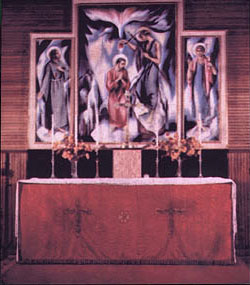


Epiphany Mission
Episcopal Church
62 Mountain Ave West
Sherwood, Tennessee 37376
(931) 598-5753
Rev. Lucy Shetters, CSM — Vicar
Episcopal Church
62 Mountain Ave West
Sherwood, Tennessee 37376
(931) 598-5753
Rev. Lucy Shetters, CSM — Vicar

One of the visitors to Epiphany Mission in 1953 was an accomplished abstract artist named Philip Perkins. He was so taken with the place and its work that he wanted to paint a new altarpiece for the chapel – a gift.
A native of Tennessee, Perkins was an abstract painter well known for his geometric, cubist influenced work of the forties. Although he was an abstract painter, for the new altarpiece he painted a triptych in a style reminiscent of El Greco's work. "I determined to paint an altarpiece with the color which I felt the church needed – a piece of religious art which was not vapidly sentimental. I not only had a desire to help the Mission, but I felt that here was a chance to experiment toward the development of a 20th Century religious art form which would have the same human communicability which had been characteristic of all religious art of the past."
The center panel depicts the Baptism of Christ by John the Baptist in the River Jordan. Above Christ is the image of a dove representing the Holy Spirit, and the hand of God is seen reaching out to Christ. John the Baptist is holding a staff made of two branches that form a cross. On the right panel is the figure of St. John the Evangelist, the apostle of love. On the left panel is the figure of St. Francis of Assisi, the patron of gardening and wildlife. On Easter, 1954, the completed triptych was presented to Epiphany Mission.
The Epiphany Mission Triptych by Philip Perkins, pictures in the chapel of Epiphany Mission. Photo from The Booklet, 1958, courtesy of John Lynch.